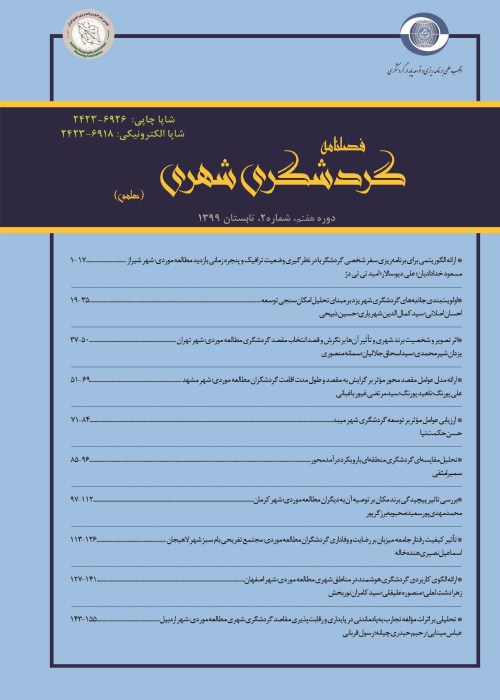An Algorithm for Tourist Personal Trip PlanningConsidering Traffic Condition and Time Windows(Case Study: City of Shiraz)
Nowadays, the tourism industry is one of the key components of economic and social development in the world. At the same time, with the growth of information and communication technology (ICT), based on e-tourism and smart tourism approach, launching websites and producing mobile applications that assist tourists in personal trip planning (based on personal profits and preferences, attractions’ information, and network traffic condition) have been considered for the tourism development and promotion of the competitive power of tourism destinations. In Operations Research (OR), the challenge of planning a tourist personal trip is a discrete optimization problem that is called the Orienteering Problem (OP). Researchers, by modeling and solving the various Ops, have tried to provide an optimal trip plan for the tourist to visit attractions considering various constraints.
In this descriptive-analytical and development research, the time-dependent orienteering problem with time windows (TDOPTW) was addressed. An Iterated Local Search (ILS) algorithm to solve the TDOPTW was proposed in the research. The algorithm was based on a number of specific neighborhood structures designed to locally improve the response that insertion, displacement, and replacement movements were used during the local search phase. In fact, in the study, in order to perceive the traffic conditions and delays on the travel time of the pass network, the travel time of the network arcs was considered as a discrete variable and a function of the day time. The proposed algorithm was coded in C++ and was evaluated by performing on a realistic dataset of the city of Shiraz. The required information can be divided into three general categories: Attractions’ information (including location, opening time, closing time, visit time, and score), road network information (including link travel time between each origin-destination pair at each time slot) and tourists consideration. The required information was collected for 38 points as POIs of Shiraz. For considering the travel time variations during the day, the time interval from 6 am to 10 pm was divided into 65 time slots with a length of 15 minutes, and at each time slot, a travel time matrix of 38 by 38 dimensions was collected by using of the online traffic map from https://developers.neshan.org/. The assumption was that the travel times were constant during each time slot.
By implementing the proposed algorithm on the real data of Shiraz, the tourist trip plan was designed in less than 30 seconds. This tour was proposed that the tourist should spend around 13.9 hours and visit 12 POIs out of 38 available ones. In order to analyze the performance of the proposed solution algorithm, different scenarios were executed on the case study. In these scenarios, changes were made to some of the input parameters of the model including opening and closing times, visit times, POI scores, the available time budget and travel times and their effect on the proposed solution was investigated. The analysis of the effect of changing the input parameters of the problem indicated that the solution algorithm was sensitive to these parameters. So that even with a minor change in one of these parameters, it redesigns and proposes the optimal solution in order to maximize the total score.
Nowadays, research in tourist trip planning concentrate on solving two main issues: a more realistic model as well as a more practical solution method. From the point of a more realistic model, this research studied the OP with Time Windows and Time Dependent travel times (TDOPTW). Moreover, the proposed solution algorithm (ILS) is able to solve the problem instances in a short computation time, while benefits from a simple and flexible structure. Therefore, in real and practical applications, by using of the proposed method for tourist personal trip enables users to find the desired route in a short amount of computation time, considering the traffic congestion in the road network as well as the service time of POIs. Based on the results evaluation of applying the proposed method on the real data of Shiraz, the high quality of the solution and short amount of computational time were considered as the advantages of the proposed method. It should be mentioned that solving such a complex optimization problem via an exact method or mathematical programming techniques might need several hours of computations on high power computers. As a result, the proposed solution strategy can be implemented in websites or mobile Apps where tourists may use to get a personal trip plan. According to the proposed method of the research, using websites and mobile apps that help in tourist trip planning, can be of an important role in the sustainable development of the tourism industry in our country and therefore attractive for public and private investments. This is a good suggestion especially for more touristic cities such as Shiraz, Isfahan and Yazd. In fact, this is a significant step toward the smart tourism in the country.
- حق عضویت دریافتی صرف حمایت از نشریات عضو و نگهداری، تکمیل و توسعه مگیران میشود.
- پرداخت حق اشتراک و دانلود مقالات اجازه بازنشر آن در سایر رسانههای چاپی و دیجیتال را به کاربر نمیدهد.


